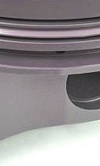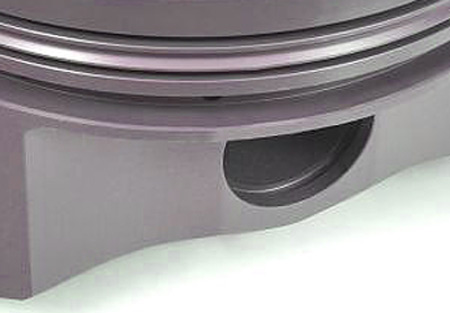Anodising
 The use of aluminium in race engines is widespread; where it is allowed, it is generally used for structural castings and is also widely used for machined components. Pistons are also generally made from aluminium, and most race pistons are forged.
The use of aluminium in race engines is widespread; where it is allowed, it is generally used for structural castings and is also widely used for machined components. Pistons are also generally made from aluminium, and most race pistons are forged.
Aluminium has a number of properties that make it an attractive material for use in race engines. For example, it has low density, and some alloys possess good specific strength (strength divided by density) and high thermal conductivity. However, there are other properties that make it unsuitable for some uses, many of which are concerned with the behaviour of the surface of the material.
Aluminium alloys are reactive, and very easily form an oxide film in air. Over a short period this isn't noticeable, but in the presence of moisture the formation of oxides is accelerated and can quickly become unsightly. One only has to look in the engine bay of a relatively new car to see the effect of using untreated castings.
Another problem is the tendency of aluminium surfaces in sliding contact to 'pick up' at relatively low pressures, especially where two aluminium parts are in contact. Fretting between aluminium parts that are bolted together can also present serious problems. And when connected electrically to a less reactive metal - not necessarily in a circuit, but just a metal-to-metal joint - in the presence of an electrolyte such as water, aluminium will corrode very rapidly.
All these problems are the consequence of 'failings' in the surface of the aluminium component. Fortunately, there are a wide range of surface treatments available based on the principle of controlled oxidation, which can solve (or partly solve) these problems. Lumped together, these treatments are widely known as anodising. However, there are two main variations on this theme, and a number of variants in each group.
To deal swiftly with the two main groups, these are based on the thickness of the oxide film produced. The thin oxide films are generally used to prevent corrosion and pick-up, and can also be dyed to produce attractive colours (depending on your taste for such things). An earlier article dealt briefly with these thin anodic surface treatments.
The thick films, which are commonly 25 microns (0.001 in) or more in thickness, are also very hard (>1000 HV) and can be used as functional surfaces, with useful wear resistance. The hard anodised coatings can also be sealed with solid lubricants such as PTFE to produce low-friction running surfaces. Hard anodised films can be dyed, but only really successfully accept black dyes.

Anodising, particularly hard anodising, is linked to a loss of fatigue strength, but there is no rule of thumb here. The method of anodising, the sealing procedure and the anodised material all have a significant effect on the loss of fatigue strength occurring due to the anodising process. Shot-peening before anodising can mitigate the effect of the anodising itself.
If you are considering hard anodising your race engine components, you would be well advised to consult your anodising supplier. They can advise on the anodising response of the material in question and on the growth you will find due to the hard anodised oxide film produced. They may also be able to advise on the method of anodising that will least affect your component in terms of fatigue, if you choose to anodise the component all over. While mechanical masking of some fatigue-sensitive areas can be expensive, it can prevent any loss of fatigue life while taking advantage of the benefits of hard anodised surface treatments.
Fig. 1 - Hard anodising of piston ring grooves has proven successful in some applications where ring 'sticking' has been a problem
Written by Wayne Ward